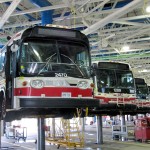
There are certain responsibilities that make up a fleet manager’s mission: choosing the right vehicles for the job, equipping them properly, building and enforcing a formal fleet policy, and ensuring a fleet’s vehicles are properly maintained and dependable.
But, none of these is more important than safety — providing an environment where safe driving is paramount, along with a policy that ensures it. Most companies have at least some pieces of a safety policy in place, and some have a complete policy. In this article, we examine what fleet managers must do to build an in-house safety program — and, if the decision is made to outsource the project, key elements to make certain that suppliers do the job right.
CREATE AN OUTLINE
As with any major project, the first step is to create an outline or summary of the content. For fleet managers seeking to implement a safety policy, this should include meeting with key stakeholders — legal, sales/service, risk management, human resources, and any other disciplines or leadership in the company whose input will be needed.
It’s important here to distinguish between a safety policy and safety program. Think of the difference this way: a policy is the “what” of safety, while the program is the “how” of carrying out or delivering the elements of the policy. For example, the policy might hold that all drivers must complete a basic safe driving course, including certification, each year. The program will provide a method for delivering, testing, and certifying the training.
Prepare a brief outline, use bullet points to describe the elements of the program:
Training: Define how often for all drivers, with the exceptions for either safe drivers or those with multiple violations or chargeable accidents.
Rewards programs: Include tracking of driver records, documentation and delivery of rewards, and the application of policy rewards qualifications
Motor vehicle records (MVRs): State when, how often, and for whom MVRs will be obtained and reviewed. Include a method for “scoring” MVRs.
Accident reviews: Include an accident review committee, which should incorporate, at minimum, fleet and risk management. Include human resources, a representative from the drivers’ function, and legal as well. The committee will review each accident to determine chargeability and the application of any penalties for violations.
Communication: Define the program, its responsibilities, and how the program will be communicated to drivers, their managers, and senior managers within the drivers’ department. The safety message must be repeated often by the fleet manager, fleet supervisors as well as drivers’ managers.
Telematics: Install device(s), data tracking, and event reporting.
These (and sometimes other) basic services will be required when the program is implemented. Include justification for formalizing the program with a particular focus on cost savings, reduced accident ratios and resulting costs.
OBTAIN PROPER APPROVALS
The next step is the most important. Upon the completion of the outline, the fleet manager will need to obtain the proper approvals to go forward with the program. These approvals, if handled properly, will go a long way toward the acceptance not only of the program, but also of the fleet manager’s authority to enforce it.
The first approval should come from the fleet manager’s immediate supervisor. It may be tempting to go right to the top, but the last person in the organization anyone would want to anger is an immediate supervisor. Make it clear, with justification, that you want the program to be approved at the highest level possible, preferably by a senior executive at the highest “C” level (e.g., CEO or COO).
The immediate supervisor will likely be able to guide the approvals through the ranks to the executive suite. The reason high-level approval is needed is a simple one: there will inevitably be requests for special consideration, particularly as it pertains to MVRs and other violation consequences.
WHAT FORM SHOULD THAT APPROVAL TAKE?
An e-mail or a hard copy memo from the CEO, endorsing the program — and giving the fleet manager full authority to carry it out and/or enforce it throughout the organization, without exception (this will particularly come in handy if the company has executive vehicles).
‘FLESH OUT’ THE PROGRAM
Now that the outline has gone through the approval process, and has been endorsed at the highest level possible, the program needs to be fleshed out, as the fleet manager develops the details of the outline, including how it will be announced and implemented.
Training:
One crucial component of a safety program is driver training; fleet managers need to determine what the focus of such training should be.
Training should focus on situational awareness and defensive driving techniques. Drivers need to know they’ll be expected to do all that is possible to avoid accidents. Training can be behind the wheel — particularly if the fleet includes trucks — online, or via testing in a classroom. The method of delivery isn’t all that important; the consistency of the delivery is.
Incentives:
Another key component of a driver safety program is providing incentives to drivers. Different people are motivated in different ways. Providing rewards to drivers with exemplary driving records can be an effective motivator. There are a number of forms rewards can take, including recognition, monetary gain, upgrades in vehicles, prizes, or combinations of any of them.
The record rewarded should be truly exemplary; five years without any violations or chargeable accidents is a good starting point. Establish levels — five years, 10 years, etc. — with increasing rewards at each level. Whatever the ultimate reward is, recognition should be part of it.
** Motor Vehicle Records (MVRs)
Also needed for a driver safety program are MVRs, which serve as the basic measuring stick for safe driving. These criteria could include: Safe drivers don’t speed, they don’t change lanes without signaling, and they obey traffic controls.
The program can assign a point system to measure the severity of any violations that appears on a record. It need not be overly extensive; a scale of one through three will work well. Three-point violations would include speeding, failure to obey a traffic signal (a light or stop sign), and tailgating. Failure to signal a turn or an illegal lane change might be at the two-point level, and equipment or administrative violations, such as expired tags, driver’s license, or inspection stickers, and burned-out bulbs, could be one point. That said, some violations, such as DUI or DWI, reckless driving, or speeding more than 25 mph over the limit, should initiate immediate consequences — they are not even subject to the point system. Finally, some system of capturing points, “scorekeeping,” and communicating results to drivers will be required.
CLICK HERE FOR PART 2.
Source: Automotive-fleet.com






